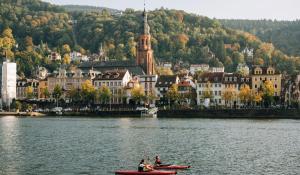
by Ayate Temsamani, Former Green America Climate Fellow
The last seven years have been the warmest on record as the climate crisis continues to rapidly drive up global temperatures and intensify storms and seasons. As the world warms, access to cooling has become increasingly critical for public health.
Yet over one billion people still lack access to cooling worldwide.
Sustainable cooling can safeguard from heatwaves, preserve food and vaccines, and maintain societal productivity. Cooling equity is necessary to promote healthy communities, stable energy supplies, and inclusive prosperous economies.
Heat equity is the development of policies and practices that mitigate heat islands and help people adapt to the impacts of extreme heat in a way that reduces the inequitable distribution of risks. Higher temperatures caused by the climate crisis will only exacerbate the growing global demand for cooling equipment.
The countries that produce the most emissions will experience less extreme heat than countries that produce far fewer emissions. As a result, the cooling technologies and fossil fuels used in wealthier countries are making life unlivable for the rest of the world. And people living in poorer and hotter countries are much less likely to be able to afford cooling technologies to protect themselves from rising temperatures and extreme heat days.
Cooling Inequity, a Global Problem
Today, more than half of the world's population lives in cities, and by 2050 an additional 2.5 billion people are expected to live in urban areas. Rapid urbanization contributes to the sharp increase in the frequency of heatwaves and makes populations across the globe more vulnerable to the effects of climate change.
The increase in population, urban densification, and climate change will only amplify urban heat islands, which experience significantly higher temperatures than other areas. The EPA estimates that heat islands will result in a 1-7°F rise in temperatures and the CDC reports that heatwaves are the deadliest of the climatic disasters facing cities.
An estimated 699 million people have little or no cooling to protect them in a heatwave primarily due to the lack of access or affordability.
The top 10 countries with the largest urban populations at risk from the lack of cooling include China with over 207 million urban poor, India with more than 110 million, and Nigeria with nearly 50 million people.
Most low-income households around the world either cannot afford cooling appliances or live in inefficient homes that are costlier to keep cool.
Roughly 3.6 billion cooling appliances are used globally today. Estimates suggest that if cooling is provided for all who need it – not just those who can afford it – up to 14 billion cooling appliances will be needed by 2050.
Sustainable cooling is crucial to achieving many Sustainable Development Goals including ending global hunger, access to affordable and renewable energy for all, and making cities inclusive, resilient, and sustainable.
How It Affects the U.S.
Cooling inequities are evident across the U.S., putting low-income and marginalized groups at risk. Climate change is burdening New York City with more acute heat island effects. Summers are hotter and longer, leaving many marginalized communities suffering and even dying.
According to WE ACT for Environmental Justice, Black residents make up 50 percent of the heat-related deaths in New York City, despite making up 25 percent of the city’s population.
The EPA attributes lack of air conditioning or the inability to afford it as factors in the higher death rates of low-income residents.
Lack of cooling access in public housing, poses health risks to many low-income and communities of color as poor insulation and old infrastructure holds heat. The Harlem Heat Project in New York City shows that marginalized groups suffer during the hot summers since the homes rarely have an air-conditioning unit.
And unlike heating in the winter, there are currently no legal provisions to make cooling a public housing requirement.
WE ACT for Environmental Justice is working to mitigate the impacts of extreme heat and advocate for better state policies to allow the Home Energy Assistance Program (HEAP) funds to be used for increasing access to more efficient cooling.
Innovative Solutions
Innovators are working to develop radiative cooling technology that follows practices used for centuries in North Africa, India, and Iran. At night, people in desert areas would pour water into shallow pits insulated with reeds and by morning the water turned to ice. The water transformed overnight by radiating its heat out into space, despite the air temperature not dipping below freezing point.
New technology follows this ancient practice using thin film to send heat into space and lower temperatures of objects, even in daytime. This innovative technology reportedly releases no greenhouse gas emissions and can save energy and lower electric bills. After solar panels, cooling panels may be the next solution for sustainable cooling, and ultimately allow us to cool entire buildings just with the sky.
For current practices, governments can invest in efficient cooling through green roofs, reflective pavements, trees, and proper building design to significantly reduce heatwave risks.
Affordable and sustainable cooling has the potential to restore environmental health and justice in communities around the world as well as improve the overall quality of life and well-being.
The COVID-19 pandemic presents an opportunity for countries to increase access to efficient cooling to low-income and marginalized communities as part of their economic recovery plans and improve energy efficiency, cooling technologies, as well as improve cold chains to reduce global food waste and provide communities in remote areas with access to vaccines and other temperature-sensitive goods.
How Refrigerants Contribute to the Climate Crisis
The appliances we use to keep cool are leaking gases that warm our atmosphere at a shocking rate. The most common refrigerants used in these appliances are greenhouse gases called hydrofluorocarbons (HFCs), which have thousands of times the warming power of CO2.
Eliminating HFCs and adopting climate-friendly refrigeration is a top solution to address the climate crisis that can prevent nearly half a degree of global warming. There is a range of refrigerant options that are available with ultra-low global warming potential to curb these emissions.
Policymakers and companies in wealthier countries have the obligation to reduce emissions from cooling and lower the climate impacts on poorer countries. Adopting better cooling now can also drive down costs so that the millions of people worldwide who need these technologies to address extreme heat can adopt them.
To learn more about cooling equity in the U.S. and worldwide, we urge you to explore the following resources:
- Heat, Health, & Equity - WE ACT for Environmental Justice
- Sustainable Recovery: World Energy Special Report - International Energy Agency
- Heat Islands and Equity - Environmental Protection Agency
- Map of Climate Friendly Supermarkets - Environmental Investigation Agency
- Take action with Green America’s Cool It campaign urging supermarkets to adopt sustainable refrigeration.






